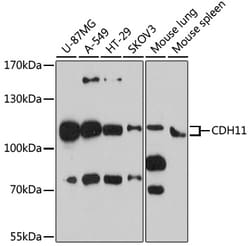Learn More
Invitrogen™ CDH11 Polyclonal Antibody
Rabbit Polyclonal Antibody
Supplier: Invitrogen™ PA596937
Description
Positive Samples: U-87MG, A-549, HT-29, SKOV3, Mouse lung, Mouse spleen; Cellular Location: Cell membrane, Single-pass type I membrane protein Immunogen sequence: ERAQYTLMAQ AVDRDTNRPL EPPSEFIVKV QDINDNPPEF LHETYHANVP ERSNVGTSVI QVTASDADDP TYGNSAKLVY SILEGQPYFS VEAQTGIIRT ALPNMDREAK EEYHVVIQAK DMGGHMGGLS GTTKVTITLT DVNDNPPKFP QSVYQMSVSE AAVPGEEVGR VKAKDPDIGE NGLVTYNIVD GDGMESFEIT TDYETQEGVI KLKKPVDFET KRAYSLKVEA ANVHIDPKFI SNGPFKDTVT VKISVEDADE PPMFLAPSYI HEVQENAAAG T.
This gene encodes a type II classical cadherin from the cadherin superfamily, integral membrane proteins that mediate calcium-dependent cell-cell adhesion. All cadherins are single-pass transmembrane proteins with a variable number of 110 amino acid extracellular cadherin (EC) domains. Classical cadherins contain five large N-terminal EC domains, a single membrane-spanning domain, and a small, highly conserved C-terminal cytoplasmic domain. Based on amino acid alignment, classical cadherins are divided into type I and type II subgroups. Type I cadherins, including cadherins E (epithelial), N (neural), P (placental), and R (retinal) cadherin differ from type I cadherins in their specific amino acid sequences. Type II cadherins include human cadherin-5, -6, -8, -11, and -12. Type II cadherins are defined based on their lack of a HAV cell adhesion recognition sequence specific to type I cadherins. Cadherin-11 (OB-Cadherin) is a marker of the loosely connected and migratory cellular elements of the mesenchyme. Strong expression of Cadherin-11 has been noted in brain, spinal cord, bone marrow and bone cells, and is regulated in human endometrial glandular epithelial and stromal cells. Expression of this particular cadherin in osteoblastic cell lines, and its upregulation during differentiation, suggests a specific function in bone development and maintenance. A variant Cadherin-11 gene (variant form) encodes a truncated protein with an unusual cytoplasmic domain not present in other cadherins. The variant protein is generated by alternative splicing, utilizing a 179 bp intronic sequence. Recently, Cadherin-11 mRNA and protein were found to be expressed in most invasive breast cancer cell lines tested but not in non-invasive cell lines, suggesting that Cadherin-11 may be a marker for aggressive, invasive tumor subsets.
Specifications
| CDH11 | |
| Polyclonal | |
| Unconjugated | |
| CDH11 | |
| CAD11; Cad-11; Cadherin; cadherin 11; cadherin 11, type 2, OB-cadherin (osteoblast); cadherin-11; Cdh11; CDHOB; OB; OB Cadherin; OB-cadherin; OSF-4; Osteoblast cadherin; osteoblast-cadherin | |
| Rabbit | |
| Affinity Chromatography | |
| RUO | |
| 1009, 12552, 84407 | |
| -20°C, Avoid Freeze/Thaw Cycles | |
| Liquid |
| ELISA, Western Blot | |
| 0.63 mg/mL | |
| PBS with 50% glycerol and 0.02% sodium azide; pH 7.3 | |
| P55287, P55288 | |
| CDH11 | |
| Recombinant fusion protein containing a sequence corresponding to amino acids 120-400 of human CDH11 (NP_0017882). | |
| 100 μL | |
| Primary | |
| Human, Mouse, Rat | |
| Antibody | |
| IgG |
Safety and Handling
Your input is important to us. Please complete this form to provide feedback related to the content on this product.
